POLISH COINS 966-1840
Coins have been issued in Poland for over 1000 years. Countless
variations exist of these medieval coins. The earliest Polish coin
was the DENAR of Mieszko I, issued before 992 A.D.
It was a small, crude silver coin without any Polish symbols on it.
It had a cross on one side, and a crown on the other. Denars issued
under Mieszko's son, Boleslaw Chrobry, began to show Polish identity.
Some of his coins show the first use of the Eagle on a Polish coin.
Most also contain Boleslaw's name in a variety of spellings, such as BOLCIZLAVS
or BOLIZLAV.
Denars were issued in many variations over the next few centuries by
successive rulers of Poland. Denars were actually fractions
of a base unit of silver, known as a GRZYWNA. A Grzywna varied
over time but was between 182.5 and 197.68 grams of silver during this
period of time. Usually there were 240 denars to a Grzywna, and sometimes
there were 265. Over the years, the purity of the silver went down.
By adding lower value metals to the silver alloy, more coins could be made
from a given amount of silver. This policy, known as debasing, occurred
to various degrees over the centuries.
Another coin that made it's appearance early in Poland's history was
the BRAKTEAT, a very small and very thin coin that had an image
on one side only. These coins often had merely a symbol on them such
as a cross, an animal, a crude face or a hand to name just a few.
Brakteats were issued by Kings, Princes, the Church and others, and remained
in use for a few hundred years.
Some Brakteats were known as "Guziczkowe" as they resembled buttons
(concave on one side, convex on the other).
Copies of Byzantine type coins were used in Poland during the 12th and
13th centuries.
Coins of other Kingdoms, such as those of Hungary and Bohemia were
also used in Poland.
German migrants also brought coins into Poland. Since Roman times,
Poles have been trading amber, which was found on the Baltic coast.
Many trade routes passed through Poland over the centuries. The traders
brought with them many "foreign" coins.
Kazimierz the Great brought about significant change in the monetary
system by introducing the GROSZ.
1 Denar = a Half Grosz. (POLGROSZE)
2 Denars = 1 Grosz.
There were 48 Groszy (or 96 Denars) to a Grzywna (197 grams of silver).
The Grosz and Half Grosz as well as Denars were issued by many subsequent
Polish Rulers.
Usually there was a Crown on one side and a Polish Eagle on the other,
but the Bohemian Lion, Royal Monogram or coat of Arms was sometimes used.
In some cases, Religious figures like the Madonna were used. Kazimierz
had no direct heir and under much protest the Polish throne passed to his
nephew Ludwik Wegierski (Louis the Great of Hungary). Some
Hungarian coins of Ludwik have Polish titles in their legends.
Ludwik died in 1382 having only 3 daughters as his heirs. After
a brief period of struggle, his middle daughter Hedwig (Jadwiga), was chosen
as "King" of Poland in 1384. She remained "King" until 1386 when
she married Wladyslaw Jagiello the Grand Duke of Lithuania.
She then became Queen of Poland. This marriage unified the Polish
and Lithuanian kingdoms. Eventually this brought about new coins
for use in Lithuania based on the Denar and the Half Grosz but with the
Lithuanian Coat of Arms or POGON in place of the Polish Eagle on some coins.
Under Jagiello, Poland defeated the Teutonic Knights who were trying to
expand southward from the Baltic sea (Prussia). Later, a small thin
silver coin known as SZELAG started to be used in these Northern
areas (becoming a copper Shilling much later). Although the
Jagiellon Dynasty ruled Poland until 1572, .the title of MAGNUS DUX LITVA
(Grand Duke of Lithuania, often abbreviated MDL) appeared on most coins
of subsequent Polish Kings, including the last Polish King Stanislaw
August Poniatowski in 1795.
During the Jagiellonian period, coins were issued for Gdansk, Torun,
Elblag, and other areas under Polish rule. Under the Reign of Zygmunt
I Stary, several new coin types were produced. They were based
on the ZLOTY system introduced in 1526. Some credit for these
monetary reforms belongs to Kopernicus, who was as much an Economist
as he was an Astronomer.
1 Zloty = 30 groszy.
1 Grosz = 3 Szelags
1 Szelag = 6 Denars
The Grosz came in many multiples. POLGROSZE = a half Grosz,
a TROJAK was 3 Grosz
and a SZOSTAK was 6 Grosz. The silver TALAR was
also introduced under Zygmunt II August in 1564. It was meant
to equal a GOLD DUKAT. The value of the Talar was 90 Grosz.
Another coin emerged as the ORT which was 18 Grosz or 1/5 of a Talar
(originally 1/4 Talar).
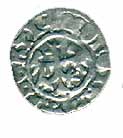
Half Gros of Jan I Albrecht 1492-1501

Half Gros of Zygmunt II August, 1559.
The Jagiellon Dynasty ended in 1572 with the death of Zygmunt II August.
The Polish Throne was passed to elected foreigners. Henryk Walezy
(Henri de Valoris of France) was the first of these Kings (1573-1574),
but resigned shortly after to take the French throne. Some coins
of Henryk minted in France name him as "King of France and Poland" long
after his abdication to the Polish throne.
Stefan Batory ( a Transylvanian) became King in 1574 and ruled
until 1586. Batory defeated the then Russian Tsar Ivan IV
(the Terrible) on three separate occasions. Most of the previous
denominations of coinage remained in use. Coins also began to be
issued from Riga.
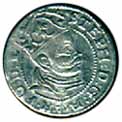
Gros of Stefan Batory, Riga, 1584
After Batory's un-expected death, Zygmunt III Wasa, a Swede,
became King of Poland. He ruled until 1632 and a vast number of coins
were struck under his rule. There are of 500 different coin variations
struck under this King from several different mints.
For information about old Polish coins struck in Riga, Latvia, click
here
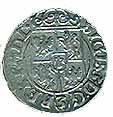
1620 Zygmunt III Wasa 3 half-gros, known as POLTORAKI
or DREIPOLCHER
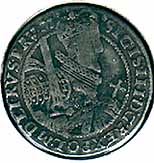
1621 ORT (18 Groszy or 1/5 of a Talar) of Zygmunt
III Wasa.
Jan Kazimierz became King in 1649 and ruled until he abdicated
in 1668. Many low value coins were struck during his reign, especially
copper Szelags. Silver coins were also produced that had a lower
percentage of pure silver in them (debased).
Under the Wettin Dynasty (August II and August III) coins minted in
other Kingdoms, such as Saxony, contained references to Polish Royal titles.
Although not really Polish coins, they can be an interesting addition to
a Polish collection.
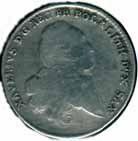
Saxony 1/3 Talar 1767, XAVIERVS DG REG PR POL & LITH
DUX SAX.
(XAVIERVS DEI GRATIA REGIUS PRINCEPS POLONIAE ET LITHUANIE)
The titles and a Coat of Arms were Passed down from August III to his
heirs in Saxony.
Major changes in coinage occurred under Poland's last King, Stanislaw
August Poniatowski.
This king oversaw the partition of Poland among Austria, Russia and
Prussia.
He also established the Warsaw mint.
Click
here to go to the Warsaw mint's site on the history of the mint.
In 1766 the Kolognian Grzywna of 233.8 grams of silver was used as the
base unit.
This was equal to 10 silver Talars.
1 Talar = 8 Zloty
A Gold Dukat now equaled 16 3/4 Zloty.
After 1786 the system was changed to 83.5 Zloty to a Grzywna and a
Dukat now had 18 Zloty.
In 1794, a popular uprising led by Tadeusz Koszciuszko led to
some Treasury notes being issued. Click
here for more info
Poland suffered a 3rd and final partition in 1795. For a short
period of time, the Grand Duchy of Warsaw issued coins. Friedrich
August, King of Saxony appeared on these coins.
Parts of Poland ruled by Austria (Galicia) issued coins from 1774 to
1794. Some coins were also issued by Prussia for areas of Poland
that it controlled.
Coins of the Russian Occupation (the so-called Kingdom of Poland or
Krolestwo Polskie) starting in 1815 are identifiable by the presence of
a Russian 2-headed Eagle. They have Polish legends and denominations
(groszy or zloty). The portrait of the Russian Tsar appears on some
denominations. Tsar Alexander also has the title Krol Polskie
(King of Poland), even though he was not the legitimate King of Poland.
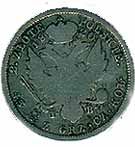
2 zlote, 1820.
These coins were discontinued after several uprisings against the Russians.
During an 1830 uprising, some coins and paper notes were issued by
the Polish "rebels". After 1830, the coins were replaced with Russo-Polish
coins, most of which had both Polish and Russian writing on them (also
both Zloty or Groszy/Rouble or Kopek denominations). Some of the
coins had Polish only, but still had the 2-headed Russian Romanov Eagle
on it. Starting in 1850, Russian coinage began to replace the
coins in Poland in order to remove any reminders that Poland was separate
from Russia. Coins were still made at the Warsaw mint, and had the
MW mint mark. This mark appears as "BM" (Cyrillic for VM) on
Russian coins minted at Warsaw.
References
Podrecznik Numizmatyki Polskiej by Dr. Marian GUMOWSKI
Coins Through the Ages, Laurence BROWN, Bonanza Books,
New York 1961
Warsaw mint's history http://www.mennica.com.pl/english/gab_num/1764_1787.html
Page on the history of the Polish monetary system http://www.bakk.com/BlazeK/monetary.htm
Click here
to return to the Money Page
